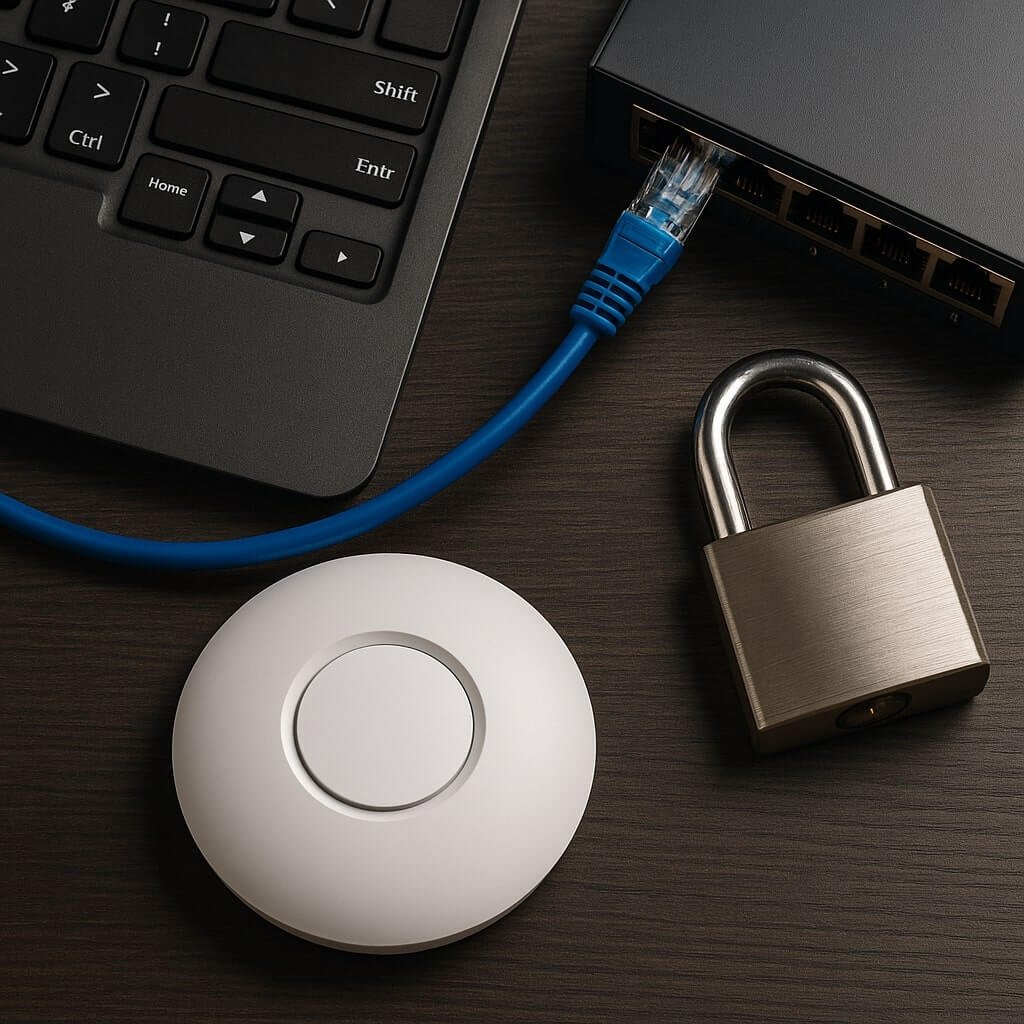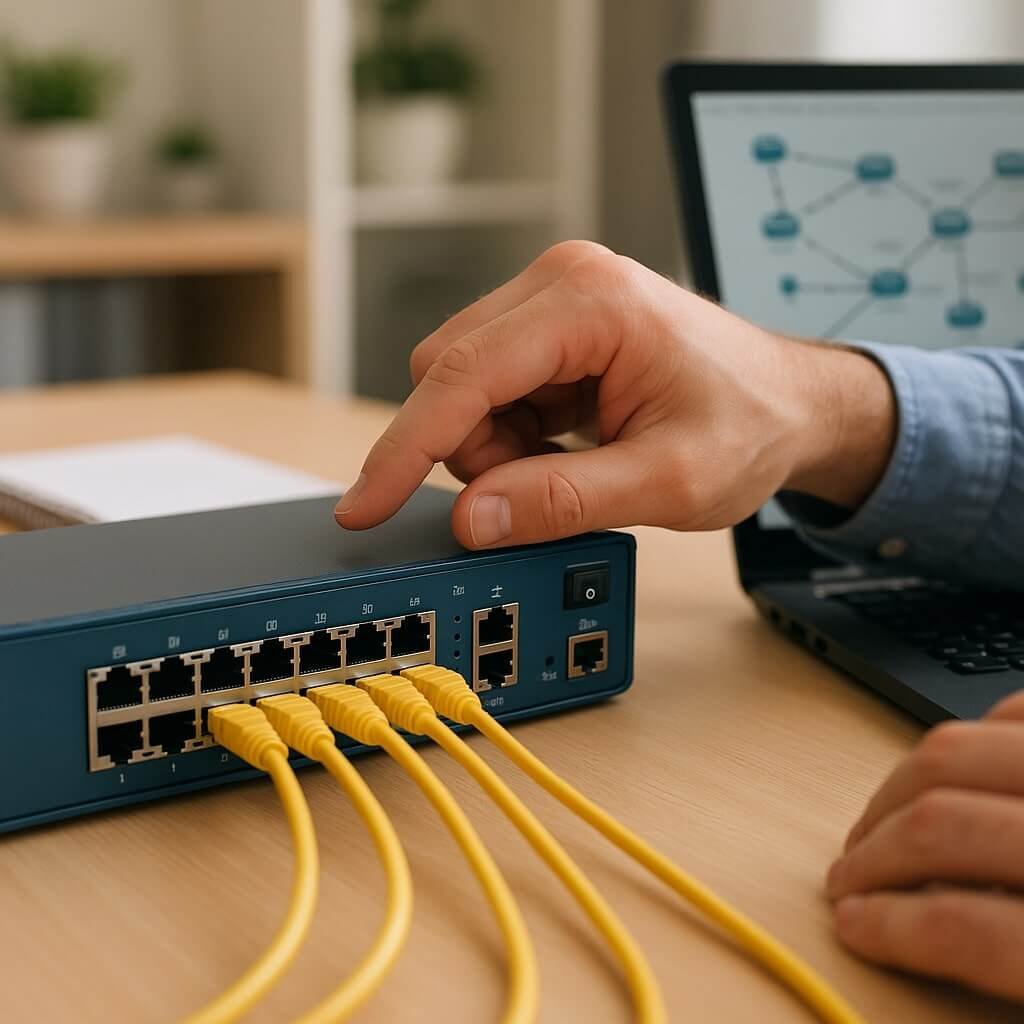In today’s digital landscape, understanding the key principles of networking information technology and security is essential for any organization. You’ll find that effective network topology, stringent security measures, and adherence to protocols are just the beginning. It’s vital to recognize how these elements interact to protect sensitive data and guarantee reliable communication. As you explore these principles, consider how they can evolve to meet emerging threats and maintain your organization’s integrity.
Key Takeaways
- Effective network topology design enhances performance and scalability, ensuring optimal data flow and coverage.
- Robust network security frameworks, including firewalls and intrusion detection, protect sensitive information from cyber threats.
- Regular monitoring and maintenance of network performance are essential for reliability and timely identification of vulnerabilities.
- Implementing strict access controls and encryption techniques safeguards data privacy and limits unauthorized access.
- Staying informed about emerging technologies, such as AI and cloud networking, is crucial for adapting security measures to evolving threats.
Understanding Networking Fundamentals
While you may think of networking as simply connecting devices, it encompasses a range of principles that are essential for effective communication and security.
Understanding network topology is critical, as it defines the arrangement of different network elements. Topologies, such as star, mesh, or bus, impact performance and scalability. You’ll need to familiarize yourself with each type to optimize your network’s structure.
Additionally, mastering troubleshooting techniques is important for maintaining network integrity. These techniques allow you to quickly identify and resolve issues, minimizing downtime.
By analyzing network performance, you can implement improvements and prevent future problems.
Fundamentally, grasping these principles lays the groundwork for a robust and reliable networking environment, ensuring efficient data flow and communication.
The Importance of Network Security
Network security is a critical component of modern IT infrastructure that safeguards sensitive information and maintains operational integrity. By identifying and addressing network vulnerabilities, you can protect your organization from potential breaches and data loss.
Implementing robust security frameworks helps you create a structured approach to managing these risks effectively. This might include adopting measures like firewalls, intrusion detection systems, and encryption protocols.
Adopting robust security frameworks ensures a structured approach to effectively managing network risks through measures like firewalls and encryption.
Understanding the importance of continuous monitoring and timely updates is essential, as cyber threats evolve rapidly. Regular assessments will allow you to adapt your security posture and guarantee compliance with industry standards.
Ultimately, prioritizing network security not only defends against attacks but also bolsters your organization’s reputation and trustworthiness in the digital landscape.
Key Components of Network Infrastructure
To build a robust network infrastructure, you need to focus on essential hardware components and effective communication protocols.
Each piece of hardware plays a critical role in ensuring connectivity, while protocols govern how data is transmitted across your network.
Understanding these elements will enhance your ability to design a secure and efficient network.
Network Hardware Essentials
A solid foundation in network hardware is vital for any effective IT infrastructure. You need to understand network cables, as they facilitate communication between devices.
Selecting appropriate router types is essential for directing traffic efficiently. Switch functions enhance connectivity by managing data flow within the network.
For wireless access, make sure you choose access points that support your network topology, allowing for ideal coverage and performance. Implement bandwidth management to prioritize critical applications.
Explore firewall options to protect against unauthorized access. Utilize subnetting techniques to segment your network for better organization.
Regular network monitoring can help identify issues early, while load balancing guarantees even distribution of traffic, enhancing performance and reliability.
Prioritize these components to build a resilient network.
Communication Protocols Overview
While understanding the intricacies of communication protocols may seem challenging, they play an important role in guaranteeing that devices can effectively transmit and receive data across networks.
Protocol types, such as TCP/IP, HTTP, and FTP, define the rules for data exchange, enabling interoperability among diverse systems. Protocol standards, established by organizations like the Internet Engineering Task Force (IETF), guarantee consistency and reliability in communication.
By adhering to these standards, you enhance network security and performance, minimizing the risk of data loss or corruption. Familiarizing yourself with these protocols can improve your network management skills and streamline connectivity.
Ultimately, grasping the fundamentals of communication protocols is crucial for anyone involved in networking and IT security.
Common Networking Protocols and Their Uses
Networking relies on several key protocols that govern how data is transmitted and received across various mediums. Understanding these protocols is essential for grasping TCP/IP fundamentals and network layering.
Networking hinges on essential protocols that dictate data transmission, crucial for mastering TCP/IP fundamentals and network layering.
Here are some common networking protocols and their uses:
- TCP (Transmission Control Protocol): Guarantees reliable data transmission, managing packet order and error correction.
- IP (Internet Protocol): Handles addressing and routing packets across networks, enabling inter-network communication.
- HTTP (Hypertext Transfer Protocol): Facilitates web browsing by transmitting hypertext requests and responses.
- FTP (File Transfer Protocol): Used for transferring files between computers over a network.
- DNS (Domain Name System): Translates domain names into IP addresses, making it easier to navigate the internet.
These protocols form the backbone of network communication, guaranteeing efficiency and reliability.
Strategies for Data Protection and Privacy
To effectively safeguard your data, you need to implement robust encryption techniques, enforce strict access control measures, and conduct regular audits.
Each of these strategies plays an essential role in maintaining privacy and security in your network.
Understanding their importance can greatly enhance your overall data protection framework.
Encryption Techniques Overview
Encryption serves as a critical shield in the domain of data protection and privacy. Understanding the different encryption techniques is essential for safeguarding sensitive information. Here’s a brief overview:
- Symmetric encryption: Uses a single key for both encryption and decryption, ensuring fast processing.
- Asymmetric encryption: Involves a pair of keys (public and private) for enhanced security, often used in secure communications.
- Encryption algorithms: Various algorithms, like AES and RSA, determine how data is encrypted, affecting strength and performance.
- Data encryption: The process of converting plaintext into ciphertext to prevent unauthorized access.
- Key management: Essential for maintaining the security of encryption keys, ensuring they remain confidential and protected.
Access Control Measures
Access control measures act as the gatekeepers of data protection and privacy, ensuring that only authorized users can access sensitive information.
By implementing robust user authentication methods, such as multi-factor authentication or biometric verification, you strengthen your system’s defenses against unauthorized access.
Each user should be assigned specific permission levels based on their role, ensuring they only access the information necessary for their tasks. This principle of least privilege minimizes the risk of data breaches and enhances overall security.
Regularly reviewing and updating these access controls is essential, as it helps to adapt to changing roles and security threats.
Ultimately, effective access control measures create a structured environment where data remains secure while enabling productivity.
Regular Audits Importance
Regular audits play an essential role in maintaining the integrity of your data protection and privacy strategies. By implementing regular audits, you can identify vulnerabilities and guarantee compliance with regulations.
Understanding the regular audit benefits enhances your overall security framework while adhering to audit frequency guidelines keeps your practices relevant.
- Detect security gaps early
- Guarantee compliance with regulations
- Enhance data accuracy and integrity
- Improve risk management strategies
- Foster a culture of accountability
Adopting a systematic approach to audits not only mitigates risks but also builds trust with stakeholders.
Regularly scheduled audits enable you to stay ahead of potential threats, guaranteeing your data remains secure and private.
Threats to Network Security and Mitigation Techniques
Numerous threats can jeopardize network security, making it essential to understand and address them effectively. You should be aware of common network vulnerabilities that can be exploited through various attack vectors, leading to security breaches.
Conducting regular risk assessments helps identify these vulnerabilities, allowing you to implement targeted mitigation strategies. Effective defense mechanisms, such as firewalls and intrusion detection systems, enhance your threat detection capabilities.
Furthermore, maintaining a robust incident response plan guarantees swift action during security incidents. Prioritize malware prevention techniques and train users to recognize phishing attacks, as human error often plays a considerable role in breaches.
Best Practices for Network Management
While understanding and mitigating threats to network security is vital, managing the network effectively is equally important for maintaining overall security and performance.
Adopting best practices for network management can lead to improved efficiency and reduced vulnerabilities. Here are some essential strategies you should implement:
- Regular network monitoring to identify anomalies and potential threats.
- Performance optimization techniques, such as load balancing and traffic shaping.
- Routine updates and patch management to keep software secure.
- Access controls to limit who can connect and what resources they can access.
- Documentation and mapping of your network layout for better troubleshooting and planning.
Future Trends in Networking and Security Technology
As technology evolves, so do the strategies and tools for enhancing networking and security, making it crucial for organizations to stay ahead of emerging trends.
Cloud networking is increasingly becoming the backbone of IT infrastructure, providing flexibility and scalability.
Meanwhile, quantum security offers unprecedented protection against cyber threats.
You’ll find AI-driven security solutions gaining traction, automating threat detection and response.
Edge computing reduces latency and enhances data processing closer to the source, but it also raises new security challenges.
The zero trust model is essential for mitigating risks, especially with 5G implications expanding the attack surface.
Additionally, blockchain integration can secure transactions, while addressing IoT vulnerabilities remains a priority for safeguarding connected devices.
Stay informed to stay secure.
Conclusion
In conclusion, grasping the key principles of networking and security is essential for anyone involved in IT. You need to prioritize understanding network fundamentals, enforce stringent security measures, and stay updated on common protocols. By implementing effective data protection strategies and regularly evaluating risks, you can enhance your network’s resilience against threats. Adopting best practices in management guarantees a secure environment, preparing you to meet future challenges in networking technology and security head-on.






